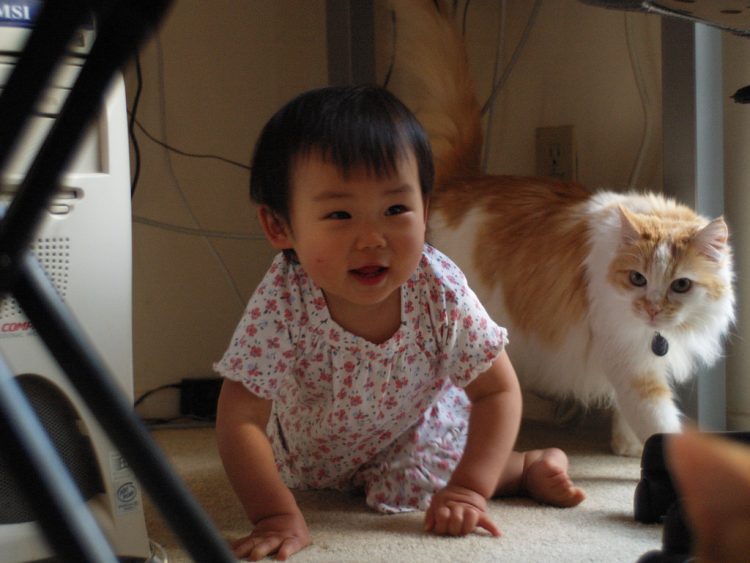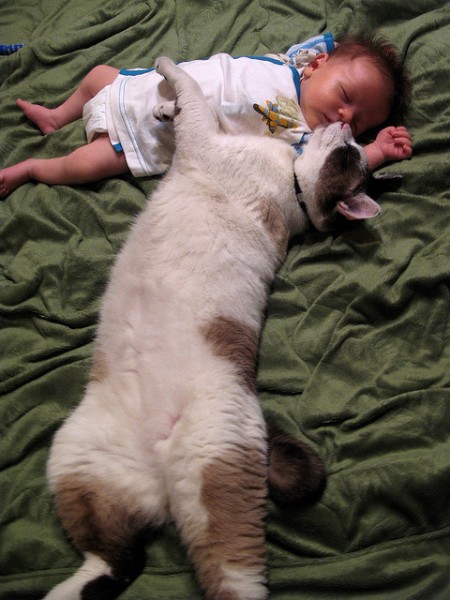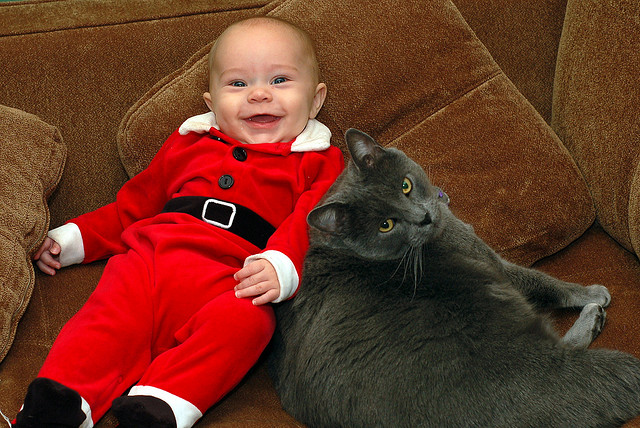
Myths about the coexistence of cats and babies have abounded for centuries.
I’ll confess that I, for one, was a little on edge in the past at the thought of a cat and a human infant even being in the same room.
But over the years, I’ve learned to separate the facts from the myths concerning cat/baby relationships.
Myth 1: Cats can tell when you’re pregnant.
Or is it a myth? According to Dr. Raymond Van Lienden, DVM, of The Animal Clinic of Clifton, Va., scents unique to pregnancy, although imperceptible to humans, can be detected by some animals — including cats.
Myth 2: You have to get rid of your cat when you get pregnant because of the risk of toxoplasmosis.
Although toxoplasmosis is a risk for fetuses, women are more likely to contract it from handling raw meat or digging in the garden than from a cat. Protect yourself from cat-related exposure by (carefully) emptying the litter box at least once a day while wearing disposable gloves and washing your hands after cleaning.
More than 60 million Americans carry the Toxoplasma parasite, but their immune systems usually prevent illness. Cats are carriers of the parasite but are rarely affected by it — they usually shed it.
Don’t panic. As Dr. Justine Lee, DVM, writes in It’s a Cat’s World… You Just Live in It, “Despite what your M.D. may tell you, you don’t have to get rid of your cat just because you are pregnant.”
So, why do some couples ship their cats off to shelter as soon as they find out they’re expecting? A lot of it is pure ignorance, really. Some people still believe the cat has it out for the baby somehow — which brings us to our next myth about cats and babies…
Myth 3: Cats smother babies or suck air out of their lungs.

Having always been told that babies were not safe around cats (because of the “milk scent” on infants’ bodies), I just about lost it one time when I saw a strange cat trying to break through a screened window to get to my baby. Grabbing my child, I called a neighbor for help. A trap was set, and the cat was caught that night.
But never again did I trust a cat around my baby.
And now, after my children are all grown, I learn that this myth is nothing more than an old wives’ tale stemming from the longtime belief that cats are symbols of evil. Most cats are just curious heat and comfort seekers. Curling up with an infant in a crib satisfies all of these needs.
If a cat presses up against the face of a bundled infant who doesn’t know to turn away on his own, this is a dire problem. Infant deaths by suffocation are most often attributed to pillows or a sleeping person accidentally smothering the infant as they sleep together.
Some cats “may become jealous and spray to cover up the scent of the baby,” according to Messy Beast blogger Sarah Hartwell. “You need to help [the cat] become more confident and less dependent upon you well before the birth,” she says.
You can ease your cat into the new routine before the baby arrives. Let the cat scope out the crib and other baby items.
You can also bring one of the newborn’s blankets back from the hospital and let the cat get used to the new scent …assuming that mother and child are in the hospital for more than 24 hours. Maternity stays aren’t what they used to be.
My recommendation? I’d keep your cat out of the nursery during napping or bedtime, just in case.
Myth 4: If a cat hears a baby crying, he will climb into the crib to harm the baby.
Cats are curious and may feel a new baby’s cries are worth investigating. As mentioned above, babies give off warmth, and a cat may try to climb in and share it, but it’s extremely unlikely that the cat would harm the baby.
Was YOUR Pet Food Recalled?
Check Now: Blue Buffalo • Science Diet • Purina • Wellness • 4health • Canine Carry Outs • Friskies • Taste of the Wild • See 200+ more brands…

Of course, it’s not recommended that cats and babies sleep together. If you’re worried about this, place a net over the crib so your cat can’t snuggle in. Or replace the door to the baby’s room with a screen door, which allows the kitty to see and smell the baby without feeling completely left out.
Myth 5: Flea bites can kill a baby.
At worst, your infant may develop a rash.
Dr. Ann L. Huntington, DVM, of Suffield Veterinary Hospital, suggests eliminating any flea problems before your child is born.
Your veterinarian can treat your cat for any internal or external parasites, while you can treat your entire home.
Myth 6: Cats are not good with babies.
In fact, the opposite is generally true. When you bring a new baby home for the first time, let your cat sniff around the infant. Allowing the cat to look at, smell and even touch your newest family member will assure your cat he has nothing to fear.
This video says it all:

Praising your pet when he behaves well with the infant teaches him that you are all one happy family. When feeding the baby, give your cat a few treats too, or play a laser game so he’ll associate good things with the baby’s presence.
Cats will adapt beautifully as long as they know they still matter to you.
Set aside some time for your cat while the baby’s sleeping. And when people come to see the new arrival, make sure they “pay attention to the cat as well as the baby,” says Hartwell.
“The baby is part of his life too, and if he is made to feel part of the baby-raising activities he will be more accepting of the noisy intruder.”
With a few guidelines and proper supervision, baby and cat can develop a loving relationship, filling your life with many happy memories.

9 Ways to Prepare Your Cat for a New Baby
Welcoming a new baby into the home is a joyful time for parents, but it can also be confusing and stressful for your cat — who may not welcome the change to “normal” routine.
Here are some steps you can take to make things less traumatic for your pet.
1. Sounds and Smells
Help your cat to adjust to the changing situation via the sounds and smells that will be commonplace once the baby arrives.
Try using baby lotion and CDs of baby-related sounds. Rewards can be used to encourage positive associations with the introductions.
2. Schedule Changes
Cats are creatures of habit, and the chaos of a baby could easily leave your cat feeling hugely distressed and anxious.
Gradually adjusting to the schedule that will be in place once the baby arrives will help your cat feel more comfortable and give him more chances to adapt to the changes that will inevitably happen.
3. Playtime Frequency
In the run-up to the birth, you may be tempted to lavish your cat with attention and affection to compensate for the baby’s arrival. But in doing so, you risk causing further confusion and stress when this doesn’t continue after the baby comes home.
Instead, use the pregnancy period to gradually move playtime to times that will still be feasible so your cat won’t feel pushed out in favor of the baby.
4. Litter Box Blues
Try to strike a good balance when deciding where to place your cat’s litter box. It should be in a spot that will not be within reach for the baby — but at the same time, it shouldn’t be in a place that your cat is too reluctant to use.
5. Spay or Neuter
If your cat has not already been spayed or neutered, this would be a good time to have it done. As well as offering health benefits, spaying/neutering would likely make your cat calmer and less inclined to act aggressively.
6. Baby Room Barriers
Will your cat be banned from the baby’s room? A robust barrier such as a safety gate will prevent access without shutting your cat out altogether. He will still be able to see, hear and smell the baby without being able to interact.
7. Crib Access
If you don’t plan to prevent access to the baby’s room, you may be worried that your cat will try to sleep in the baby’s crib. Discourage this from the start by attaching double-sided sticky tape to the edges so that your cat is not so keen to access the crib. This will create a negative association with the crib.
8. Refuge Room
If you are expecting to receive guests after the baby comes home, set up a quiet room where your cat can seek sanctuary. This also be where your cat goes to get away from the baby if things become overwhelming. The room should contain food, water, a litter tray and a comfortable sleeping area.
Check in with your cat regularly while this room is being used and offer treats and affection. If he doesn’t want to come out, don’t force the issue — wait until he feels comfortable enough to venture out.
9. Escape Tower
Set up “perches” that your cat can use to escape from the baby. This can be as simple as cat trees or scratching posts with platforms. These should be suitably out of reach for a toddler in preparation for the baby learning to crawl.
* * *
Cat behaviors writer T.J. Banks contributed to this article.


